#build: obrero
Text
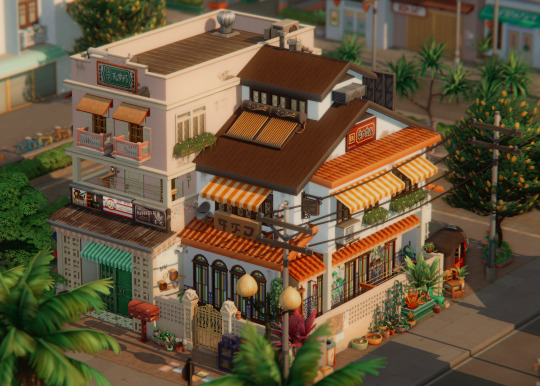
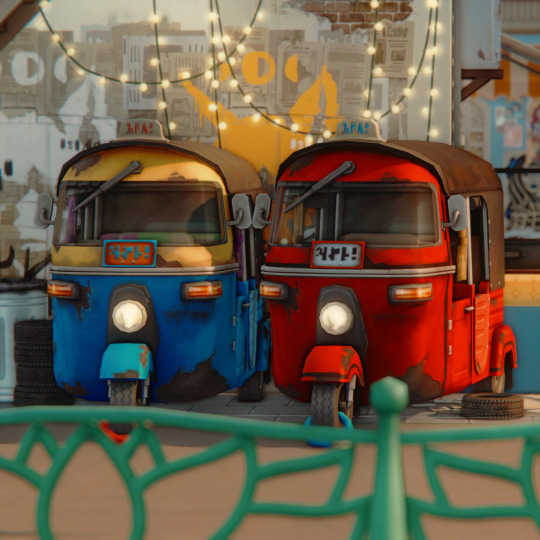

🎇 morensong, tomarang
#posting @ a weird time but finished 2 builds!! waaah#i'll try to share them tomorrow/this weekend :3#the sims#ts4#ts4 vanilla#ts4 build#ts4 builds#ts4 exterior#ts4 for rent#btw. have i mentioned that i love this pack.#tomarang#build: obrero#build: kanto viscaya#named after the streets i grew up in bc im feeling sad and nostalgic this holiday season sfsfsfffggf
516 notes
·
View notes
Text
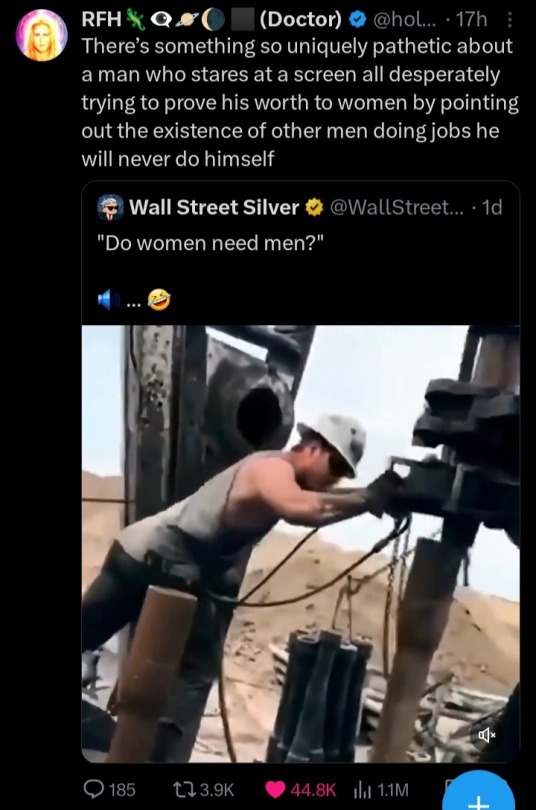
#GRACIAS!! no sos un obrero precarizado matías trabajás en atencion al cliente en el banco república#“men build houses” and how many houses have u built baby boy??
22 notes
·
View notes
Text
MarketDataMexico - Unidad Obrera
"Unidad Obrera" is the name of the new latino-American political movement based in Mexico City. Founded in 1989, the party is a part of the labor movement and has a strong international presence. The group's members are mainly indigenous, but they also include people from other hemispheres. Originally, the term obrera was used to refer to the community of indigenous people in the Americas.
The population of Unidad Obrera is approximately 2,000 people. Approximately 600 people are under the age of 14 while another 800 are between the ages of 15 and 29. MarketDataMexico estimates the annual output of the area at $260 million, which is equal to $98 million per person and $160 million per establishment. As for the number of people working in the community, there are approximately 200. The town is a part of the larger Baja California metropolitan area, and its population is growing.
The UOC's mission is to develop grassroots organizations throughout the region. These organizations are vital to achieving the class-independent goals of the working class. Their work contributes to the empowerment of small farmers and improves their economic and social management skills. It aims to build a more democratic, egalitarian society. There are many reasons for this goal, but the most important one is to help the poorest people in the world reach their full potential.
The organization of obreras began in 1933. Initially, they were organized into various local groups. However, a more organized approach emerged. The United Autonomous Community in Mexico was formed in 1934. The CSLA was tasked with the preparations for the meeting. Its main goal was to achieve obrera unity. The pact was signed on 14 January 1936. Learn more was pleased with this result, and ratified it.
The undocumentados are not only anti-worker organizations. They are strategic allies in the imperialist struggle. They are highly sensitive to the profits of capitalists. The undocumentados have been one of the most successful and popular labor unions in the world for decades. In contrast, it is a strategic ally for the imperialists in the international context. It is a part of the global elite.
In 1937, two meetings were held in Chile and Argentina. The meeting's participants came from different obreras across the Americas. At the meeting, obrera leaders agreed to a pact to unite all workers in the continent. They also agreed to create a unified political party for the obreras. As of today, they have been the strongest and most influential in the Latin American Union since it was founded.
Aside from being a part of the labor movement, Unidad Obrera is an important part of Tamaulipas. It is located in the state of Tamaulipas. It is the largest city in the state. There are a number of other cities in the area. For example, Reynosa is the state of Mexico, and its capital is La Paz. In this region, Unidad Obrera is a small city in the province of Tamaulipas.
Despite the size of the city, Unidad Obrera has relatively few commercial establishments. Its population is only 1,990. The area has 517 dwellings. Its density is 1,145 people per square kilometer. Its residents have an average age of 24 and have nine years of schooling. This makes Unidad Obrera a very interesting place to visit! You can't wait to explore it!
The town has very few commercial establishments. It has a population of 1,990 and 517 dwellings. It has a low density of population and is relatively rural. The average age of the people in Unidad Obrera is 24 years old and has a schooling level of nine. The average income in this city is $13,100. The average house price is $780. You can also find a great deal of food in the area.
While there is still an active labor movement in Unidad Obrera, the pact to unite Latin America was signed by many obreros in 1936. Its aim was to unite the obreras of the Americas. The pact was signed by presidents of Mexico and Uruguay and later the CSLA. This pact was signed on 14 January 1936. Afterwards, the CSLA ratified the pact, and the obreras of other latino-american nations, and the obreras from different parts of the world.
0 notes
Text
POSIBILIDADES EN LA CONSTRUCCIÓN DE EDIFICIOS COMPLEJOS Y DE GRAN TAMAÑO EN LA ANTIGUEDAD
sábado, 17 de diciembre de 2022
Los documentales Secrets of the Parthenon, Building the Great Cathedrals y Great Cathedral Mystery, tienen en común descubrir y resolver los secretos de cómo los antiguos arquitectos, ingenieros y artesanos construyeron edificios impresionantes solo con herramientas tradicionales, por lo tanto, en el presente escrito compartiré algunas habilidades que considero que fueron importantes en el proceso de diseño y ejecución de obras de construcción de los majestuosos edificios clásicos.
Luego de ver los 3 documentales, puedo entender que los antiguos ingenieros, arquitectos, obreros y artesanos demostraron ser altamente intelectuales, creativos, ingeniosos e integrales. Gracias a lo mencionado anteriormente, les permitía identificar procesos, patrones, y solucionar problemas complejos en el diseño y la construcción de los edificios.
Considero que los profesionales de ese entonces emplearon parte de estas habilidades para crear metodologías constructivas que les permitieron materializar edificios con los valores, creencias e ideología de su época. Los griegos contaban con la habilidad y conocimientos para innovar procedimientos teóricos y prácticos. Dos ejemplos en las disciplinas que destacaban fue en la geometría y la física.
Por otra parte, los constructores de la Edad Media fueron excelentes observadores e ingeniosos para la construcción. Así que, para estas dos épocas, estos conocimientos y habilidades fueron clave en el diseño arquitectónico y la construcción de edificios de grandes dimensiones y altura solo con materiales que estuvieron a su alcance. La intelectualidad, creatividad, la capacidad de ser ingeniosos y completos era notable en la época de la Edad Media y la Antigua Grecia. Son estas habilidades las que llevaron a estos maestros a descubrir y aplicar la física (estática), el conocimiento de las propiedades de los materiales y la geometría. Quiénes dominaban estos conocimientos necesarios, lograron desarrollar técnicas constructivas que les permitía llegar al punto de desafiar la gravedad. Esto es una demostración fuerte, donde demuestra cuán capaces son los seres humanos.
Los antiguos ingenieros, arquitectos, obreros y artesanos demostraron ser altamente intelectuales, creativos, ingeniosos y profesionales completos. En la antiguedad, los maestros que construyeron grandes obras arquitectónicas, fueron personas multidisciplinarias. Por ejemplo: ser artista, filósofo, matemático y arquitecto; estas disciplinas son complementarias y tiene como beneficio tener una variedad de perspectivas que les permitía encontrar soluciones, ser eficientes, tener ideas ingeniosas e innovar.
Ambas épocas tenían sus puntos fuertes y débiles, sin embargo, lograron llevar a cabo construcciones impresionantes de acuerdo a sus habilidades. Los griegos inventaron sistemas de maquinaria como la grúa para facilitar el proceso de construcción en levantar materiales pesados como las piedras. Esto es gracias al conocimiento en la geometría y la física. Sin embargo, los constructores de la Edad Media su ingenio se debió gracias a la observación de los edificios ya existentes y de las ruinas, a partir de esta observación procedian a experimentar construyendo estructuras.
Para concluir, a pesar de mencionar algunas posibilidades de habilidades y conocimiento que tenían estos maestros y obreros, conforme a lo que observe en los edificios que presentaron en los documentales. Aún sigue siendo un misterio, ya que, los equipos que se dedican a la restauración, se tardan mucho más que los maestros que la construyeron en la antiguedad utilizando únicamente herramientas tradicionales y materiales locales como lo es la piedra, hierro y madera. De todas formas, me parece interesante el hecho de que están reconstruyendo para entender y descubrir las técnicas que estos empleaban en la antiguedad.
Referencias
Secrets of the Parthenon. (s. f.). NOVA | PBS. https://www.pbs.org/wgbh/nova/video/secrets-of-the-parthenon/
E.T.S. Arquitectura (UPM). (s. f.). La ciencia medieval de las estructuras - Archivo Digital UPM. https://oa.upm.es/45327/
Building the Great Cathedrals. (2010, 20 octubre). NOVA|PBS. https://www.pbs.org/wgbh/nova/video/building-the-great-cathedrals/
Great Cathedral Mystery. (2014, 13 febrero). NOVA | PBS. https://www.pbs.org/wgbh/nova/video/great-cathedral-mystery/

0 notes
Text
Unidad Obrera - The Music of Unidad Obrera
The music album by Unidad Obrera is an inspiring example of the union's power. The songs in this collection are both powerful and moving. They are a reflection of the Argentinean nationalist spirit and its socialist ideals. The song "Bailando" is an excellent example of the obreras' ability to organize their forces to gain power. It is also a good example of a Latin American union gaining a national presence.
It is important to understand the history of Unidad Obrera. It is one of the first movements to demand a common minimum program. The obreros believe in international politics, and that the threat of fascism is present on the world stage. The name is an apt description of the obreras' revolutionary struggle. This is one example of the importance of unity within the work class. While working for unification, the obreras are able to defend their rights against the fascists' attacks.
In the early 1930s, the pact for obrera's formation was approved by President Franklin D. Roosevelt. In the United States, he authorized the Mexican dirigente to travel through America to convene the first Congreso Obrero Latinoamerican. This congress was supposed to bring the pact for obrera to Chile. In the end, this meeting ended up being the beginning of the obrera movement, which has become a prominent force in today's world.
The pact for obrera aims to create a unified working class by uniting the obreras throughout the world. It has a latinoamerican context and international antecedent. It has taken place during a period of democratization and international crisis. The rise of totalitarian movements in Latin America has been a major factor in the rise of Unidad Obrera.
Among the pact's goals was a common minimum program for workers. It was also a priority in Lombardo Toledano's international politics. The pact was made on the basis of an unifying agenda, allowing the obreras to achieve their common goals. And, the pact's success was crucial. The obrera pact's agreement was a step in the right direction.
Among the pact's goals was the creation of a working class. The obrera pact's key objectives were democratization, class independence, and solidarity. By promoting such a pact, the obreras were able to mobilize the masses of poor people and campesinos in the hemisphere. In short, the obreras are the most influential union in Mexico.
The obrera pact was a pact that was made by the unions in Mexico, Chile, and Uruguay to create an independent union. The pact emphasized the unity, solidarity, and class independency among all workers. In this way, the obrera pact was signed in the name of the Mexican Workers' Party. This pact is the first obrera pact, but it is a precursor to the formation of a continental obrera.
The obrera pact was signed by the CSLA and ratified by the obrera unions in all five countries. The pact stressed that a continental union should not be postponed. In fact, the obrera pact was unanimously endorsed by all the countries of the region. Its ratification by the CSLA was a landmark for the obrera pact.
The pact was signed by the representatives of obrera organizations and the Lombardo toledano. The pact outlines the common minimum program and other principles of the organization. Furthermore, it is an important step in the formation of a continental obrera pact as a step toward democratization. In addition, it also allows for international expansion of the revolution. It is a political and social pact that focuses on the interests of the obrera community and its people.
The pact is a step in the right direction for the working class. The unification of the working class is one of the most fundamental principles of the movement. It is the most powerful part of the PSI's manifesto, recognizing that it is the most effective form of resistance against US imperialism. This is the pact's key to building a more progressive future for the world. However, it is also the most important step in the process of a socialist society.
The first pact was signed in Chile and the United States in 1932. This pact was signed between the two countries because the obreros wanted to improve the welfare of their country. By ensuring unity, the obreros would be able to achieve their goal. If the obreros were unified, the United States would be the most prosperous continent. The pact was not, however, fully implemented.
1 note
·
View note
Photo

#Construcción #Construction #Building #Bau #construcció #albañil #contratista #contractor #obrero #castillo #trabe #muro #losa #beam #slab #wall #columna #column #forjado #colado #concreto #concrete #acero #steel #Brick #mampostería #masonry #mason #ladrillo (en Ocotza, Hidalgo, Mexico) https://www.instagram.com/p/B2JtoSsFeCx/?igshid=p4wirnh6crbz
#construcción#construction#building#bau#construcció#albañil#contratista#contractor#obrero#castillo#trabe#muro#losa#beam#slab#wall#columna#column#forjado#colado#concreto#concrete#acero#steel#brick#mampostería#masonry#mason#ladrillo
0 notes
Text
Sergio remembers his beloved brother Cele
Even though I think about Cele all the time and the fact that I’m still struggling with the reality of his departure, writing my memories of him is not easy. Not only because I’m a lousy writer but because it is hard for me to focus. My thoughts are all over the place. I start thinking about when we were kids but my mind starts wondering to other places in time, always with him in mind. Well, I decided to start writing and see what comes out. I love you bro.
The first memory I have of Cele is him reading a book. I see him lying down on the couch or in bed, always with a book on his hands. Cele is (was) 5 years older than me and I can’t remember much that far.
Cele went to live and study in Italy when he was 14 and I was 9. I clearly remember the day of my first communion (don’t know how old I was but maybe 10?). My mother, Fernando and I took the elevator in the building we lived in to go down to the lobby. When we got off and start walking through the lobby, we met face to face, this guy with his hair down to the shoulders (in those years, long hair people in Caracas were the handful of hippies in Los Caobos), a sport jacket (nobody had those) and most impressive, a kind of male purse (maricometro). We didn’t recognize him at first but then everybody started jumping and crying. It was Cele that had just arrived and surprised everybody. Love you bro.
Another time that he came back for vacations, my father asked him and Fernando to paint his office. Of course they took me with them to make me do all the work. I remember the bus ride to El Centro, listening to Elton John music (ever since then, every time I hear an Elton John song I remember Cele) and then the 10 block or so walk to my father’s office. I remember one time Cele was painting the top half of a wall and I was painting the lower half. I heard him calling me and turned my head up when….. plush plush, my face was painted all white!
Acabo de darme cuenta que estaba escribiendo en inglés (muchacho pajúo! me diría Cele).
En uno de esos viajes de vacaciones, Cele tuvo el accidente. Tiempos difíciles y de los cuales no recuerdo mucho pero se que el jugaba ping pong en Italia y al regresar, después del accidente, empezó a jugar con el brazo izquierdo y se ganó una medalla. Arrecho brother!
Cuando Cele regresó definitivamente de Italia, se fue a trabajar a San Cristóbal. Recuerdo que tuvo una novia (Nieves?) y que en una oportunidad, estando yo todavía chamito, el y ella estaban fumando y Cele le dijo que aspirara el cigarrillo y me pasara el humo a mi. Por supuesto, ella tenía que besarme para pasarme el humo y yo (chamito), estaba más emocionado que el carajo!
Recuerdo que pasé unas semanas visitándolo en San Cristóbal. Mi tía Ramona nos llevaba con sus hijos a la piscina del hotel Tama. El agua siempre fría pero como nos gustaba ir. A Cele siempre le gustó nadar.
Ya viviendo en Caracas nuevamente, nos íbamos al club táchira a jugar ping pong y bañarnos en la piscina. Como no teníamos carro, nos íbamos en autobús hasta Bello Monte y después subíamos pidiendo cola. Muchas veces nos tocó caminar la mayoría del tramo y llegábamos super mamados, lo que hacía meterse en el agua algo super agradable.
Recuerdo que jugábamos ping pong y la gente nos veía, impresionados con Cele y su habilidad, pero los carajitos chiquitos siempre se quedaban viéndolo y preguntando pendejadas. Yo me molestaba muchísimo pero Cele siempre muy calmado, les explicaba que había pasado.
Un día estaba yo durmiendo todavía como a las 12 del mediodía (ya tenia como unos 13 años), cuando llegó Cele con una mesa de ping pong de regalo para mi. Que sorpresa!! Inmediatamente la armamos y se prendió la parranda. Todos en la familia pasamos buenos ratos jugando hasta tarde. ¡Gracias Cele!
Tiempo después, estando Cele casado con Tita, fui a visitarlo un Viernes por la tarde al apartamento que tenía en el centro. Yo tendría como unos 18 años. Cuando Tita me abrió la puerta me dijo, gracias a dios que viniste y al pasar veo a Cele metido en la ducha con tremenda pea! Lo único que decía era, no me regañes mi amor. Ayude a Tita a sacarlo del baño, ponerle un short y acostarlo.
Después me fui yo de Venezuela a estudiar. Cada año que regresaba a pasar las vacaciones de diciembre, mi papá y Cele me ponían a hacer algo en la fábrica. Tender la tela, cortarla, amarrarla y llevarla a que la cosieran o si ya estaba listo el producto, a distribuirlo entre los clientes (hacer el despacho). Recuerdo que para ir a donde la comadre a llevarle la cobija para coser, había que pasar por unos barrios bien jodidos y feos en un cerro de Antímano. Ella, por supuesto, vivía en la última casita del cerro. Cele les decía que yo era el obrero más caro del mundo y que me traía de los EEUU especialmente para hacer los despachos. Es importante decir que a Cele lo querían muchísimo ahí en ese cerro. Era fascinante ver como desde abajo en la avenida (no recuerdo el nombre) ya lo reconocían y lo saludaban con cariño. Luego subiendo el cerro siempre había gente que lo saludaba y en casa de la comadre, al verlo llegar, mandaban a comprar cerveza para invitarlo. En ese entonces, Cele trabajaba en Rosetón, una fábrica de textiles que quedaba en Antímano. Él era el supervisor del tercer turno. Yo me sentía super orgulloso de él al ver tanto cariño que le tenían.
Cele hermano querido, me haces mucha falta. Te recuerdo mucho pero escribir estos recuerdos es muy jodido …. a la vez hermoso.
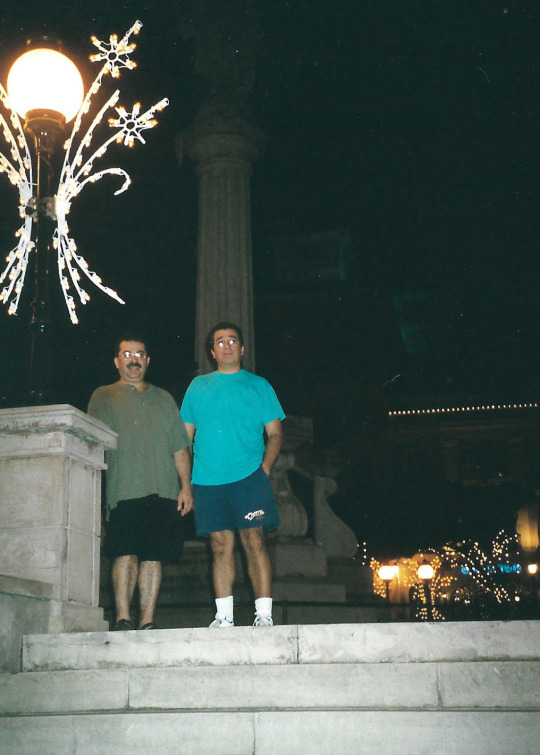
Recuerdo cuando íbamos a los juegos de béisbol en el universitario. Tu de la Guaira, yo del Caracas. El estadio siempre full y tú decías que era el bar más grande de la ciudad. Recuerdo ir a Puerto Cruz al apartamento de Fer y una vez que nos acompañaste a casa de una prima de Anyumir. Fuimos a playa colorada y nos caímos a palos como los buenos. Recuerdo los viajes a Acarígua a pescar con los tíos. Como gozabamos. Una vez estábamos caminando en el río y te tiraste un clavado, cuando saliste tenías la ceja rota de un coñazo que te diste con una rama.
Te recuerdo siempre que escucho a Rubén Blades cantando “Creo en ti”. Te veo claramente cantando esa cancion a todo voz en mi apartamento de Barúta. Te recuerdo cantando Tim Marin de Alí Primera “muchacho tráigame los fósforos que esta madera va a arder”, recuerdo tu cara, recuerdo tus miradas, recuerdo tu voz.
Y como olvidar los desayunos con arepa, chicharrón, aguacate y queso blanco fresco en tu casa de Miramar!
–Sergio
1 note
·
View note
Text
COMMISSIONS OPEN! [Please Read Below if you Can]
Minna-san Konnichiwa! It’s been a while!
I’ll go straight to the point. The reason I’m opening commissions it’s due to a situation on my home island. Puerto Rico has been struck with none stop multiple earthquakes since the 28th of December. This whole situation has caused GREAT damage physically and mentally to my people. Many have lost houses, forced to sleep outside at night due to the fear, paranoid, etc. Myself included. So in the mean time, I’m in the USA, to raise some money to send back to my folks or give to charity.
If you’d like to contribute to charity directly, I have a list provided at the very end of this list.
SO....
I’ll be opening Ko-Fi quick sketch Character Commissions! If you’d like more info, Click Here! [X]

As for Regular Commissions, the info is here:


REMEMBER TO MAKE IT CHARACTER FOCUSED AND PATIENCE IS IMPORTANT, I’M NOT A FAST ARTIST BUT I TRY MY BEST!
If you’d like to donate as well to charity, I’ve compiled a list below for more info. DO NOT DONATE DIRECTLY TO THE MAIN GOVERNMENT OF PUERTO RICO! MOST OF THOSE FUNDS WILL NOT MAKE IT TO THE PEOPLE IN NEED!
Any support is greatly appreciated!
OPTION 1: Habitat for Humanity -They build houses to those who were affected by a disaster. The folks are required to take a “charlas” which is like a chat or info beforehand about how to manage disasters and such.
They also have a website at: https://english.habitatpr.org/welcome.html
~~~~~~~~~~~~~~~~~~~~~~~~~~~~~
OPTION 2: Florida NGO’S Coalition for PR Earthquake -It’s composed of 26 none profit organizations that have united to help in search and rescue. They have a collection center in their warehouse, located in the Arecibo Shopping Center.
INFORMATION: 1-877-354-0810, Option #4 (Help Line). They manage funds and help to those organizations.
~~~~~~~~~~~~~~~~~~~~~~~~~~~~~
OPTION 3: United States Coast Guard Auxiliary -They have a 1 to 5 team in Dorado (Located in the Casa del Obrero, Street 693). They’re recollecting items none perishable, canned foods and water to take em to the affected areas.
INFORMATION: Contact Capellán Ramón Malavé Marty at 787-702-8717
or
e-mail: [email protected]
~~~~~~~~~~~~~~~~~~~~~~~~~~~~~
OPTION 4: Banco de Alimentos de Puerto Rico -They’re collecting none perishable items: Canned Foods and various other foods, water, hygiene items and such. You can also donate through ATHmovil/bancodealimentosdepr
INFORMATION: 787-740-3663
~~~~~~~~~~~~~~~~~~~~~~~~~~~~~
OPTION 5: Puerto Rico Rise Up (PRRU) -This none profit organization was founded and managed by a group of puertorrican doctors. They’re help is slightly different since they assist on the medicinal aspect.
INFORMATION: They have a facebook page at https://facebook.com/PRRUp
~~~~~~~~~~~~~~~~~~~~~~~~~~~~~
OPTION 6: Centro de Acopio en Yauco -This is basically a collection center they formed at Yauco stadium in my hometown. As usual, Items such as foods and such. They group up there to then send the help to the needed communities.
INFORMATION: *Ricardo Cedeño at 787-242 3801, *Jorge (Emergency Management) 787-614-4088, *E-mail at: [email protected]
~~~~~~~~~~~~~~~~~~~~~~~~~~~~~
OPTION 7: Singer, Tito Auger from the band Fiel a la Vega -He’s been managing most things with his own team. He gathers supplies and distributes them to affected areas and later posts receipts of the purchases he’s made so people know where their donations are being used.
INFORMATION: His Facebook https://facebook.com/TitoAugerCantautor/…
~~~~~~~~~~~~~~~~~~~~~~~~~~~~~
OPTION 8: Direct contact with municipalities -Mayors and community leaders are the ones who are moving things in their areas and probably have the best idea as to which communities need the most help. The logistics might be tricky, but it’s a plausible option.
The most affected municipalities are:
•Guanica •Guayanilla •Yauco •Peñuelas •Ponce
There are a few other towns that have suffered damages, but these are the closest to the epicenter of all the seismic activity.
13 notes
·
View notes
Text
Art Deco
El art déco es un movimiento artístico que predominó en la arquitectura, el arte, el diseño gráfico, el diseño interiores y el diseño industrial entre los años 1920 y 1939. El art déco se caracterizó por la utilización de figuras geométricas delineadas con precisión y la utilización de colores fuertes y llamativos.

El movimiento surge como una forma de imprimir optimismo después de la depresión de la Primera Guerra Mundial. El art déco buscaba orientación hacia un futuro adoptando ideas modernas como una celebración hacia el progreso.
El estilo del art déco tuvo influencias de las corrientes del vanguardismo que lo antecedieron como el cubismo y el futurismo, pero se diferencia por estar cargados de motivos de culturas antiguas como, por ejemplo, la egipcia, la asiática y la de Mesopotamia. En este sentido, el art déco es considerado el primer estilo decorativo global.

Representantes
Tamara de Lempicka
Jean Dupas
Erté
Paul Poiret.

Características
El Art Déco se basa principalmente en la geometría imperante del cubo, la esfera y la línea recta, además de los imprescindibles zigzags.
Tratan de representar algunas abstracciones que muestran en la naturaleza, rayos luminosos radiantes, fluidos acuáticos, nubes ondulantes.
Representación faunística haciendo referencia a ciertas cualidades como la velocidad y usan para ello gacelas, galgos, panteras palomas, garzas.
Representación de elementos fitomorfos se utilizan las flores, los cactus, las palmeras, representados por medio de delineaciones geométricas.
Utiliza imágenes de fuentes congelas de formas ascendentes.
Utilización de nuevos materiales como la baquelita, el cromo y el plástico, maderas nobles el ébano y el palisandro, pieles naturales de zapa, de tiburón y el carey.

Se utilizan motivos de las culturas pre hispanas de las culturas azteca, maya o inca y motivos inspirados en los objetos de los descubrimientos arqueológicos de Egipto, Mesopotamia, vikingo o de los pueblos africanos o indios.
En arquitectura, además de las formas geométricas, se recurre a remates terminados escalonadamente y con proas marítimas que sostienen mástiles que sirven como astas; arcos, puertas ochavadas y lujosos materiales como el mármol, el granito y el aluminio consuman el aparato decorativo.
Se utiliza la figura humana de hombres gimnastas, obreros, habitantes de las urbes, luciendo el "look" de la época, junto a la de mujeres resueltas que participan en la producción económica, vistiendo una moda más atrevida, con el pelo corto a la "garzón" que fuman y participan en cócteles, denotando su liberación.

Arquitectura
Un exponente del Art Deco es el edificio de Chrysler en Nueva York diseñador por William Van Alen. Los arquitectos Art Deco a menudo sellaban sus construcciones con imágenes simbólicas. El Art Deco tomó la austeridad de las formas de la Escuela Bauhaus y la línea aerodinámica de la tecnología moderna combinada que patrones e íconos tomados del lejano este, la Grecia Antigua, Africa, India, Roma, los mayas y aztecas.
El término Art Deco, se acuñó en la Exposition Des Arts Decoratifs de París en 1925. Robert Mallet-Stevens ayudó a promover la arquitectura Art Deco en Europa. En los Estados Unidos, el Art Deco fue desarrollado por Raymond Hood, quien diseñó tres de los edificios Art Deco más importantes de Nueva York. El Radio City Music Hall, auditorio y el edificio RCA construido en el Rockefeller Center, y el edificio New York Daily.
El edificio Crhysler, está adornado con decoraciones de águila, los cubiertas de neumáticos e imágenes abstractas de coches. Otros arquitectos Art Deco utilizan flores estilizadas, rayos amarillos, como las aves y los engranajes de la máquina. Algunas construcciones Art Deco sugieren formas de pirámides egipcias o asiáticas.
Desde los rascacielos y las salas de cine a las estaciones de gas y viviendas particulares, la idea de usar los iconos de la arquitectura se convirtió en el grito de la moda. Los colores terracota y las bandas de colores en dirección vertical son típicas del Art Deco copiados de la antiguedad.
Zigzag Moderne
Teatro Éden de Lisboa
Edificio de La Unión y el Fénix de Madrid
General Electric Building de Nueva York
Club Paramount de Shanghai
Observatorio Griffith de Los Ángeles
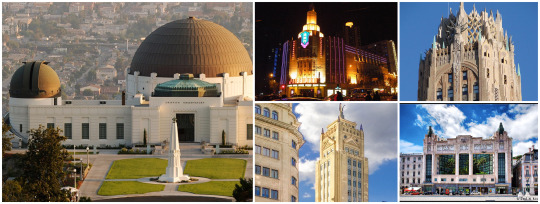
Streamline Moderne
El edificio Chrysler de Nueva York

Neo-Art Decó
Torres de Colón de Madrid
Centro comercial de Las Rozas Village

Interiores
El Art Decó en el diseño interior se caracteriza por los colores ricos, formas geométricas y los detalles potentes. Alcanzó el apogeo de su popularidad en la década de 1920, 30 y 40, es el estilo del glamour, el lujo y los diseños simétricos de formas exuberantes.
Los espacios Art Decó cuentan con revestimientos de paredes y accesorios en todo su esplendor. Ya sea que incorpores Art Decó de suelo a techo o que simplemente quieras agregar unas sillas al resto de tu decoración, estos detalles seguramente mejorarán tu espacio.
Las maderas exóticas, los motivos geométricos y los acabados alto brillo distinguen al estilo Art Decó en el diseño interior. Tiene toques de la cultura francesa, egipcia y mediterránea.

Mobiliario
La consola: Es el elemento más representativo del mobiliario de las artes decorativas, a menudo utilizado como mesa auxiliar, con una línea delgada y una superficie plana, donde se colocaron jarrones, estatuas de bronce u objetos de arte Deco.

Bar: El mueble bar está hecho de madera maciza y reforzado con una preciosa chapa, que ofrece una gran durabilidad y una estética incomparable.
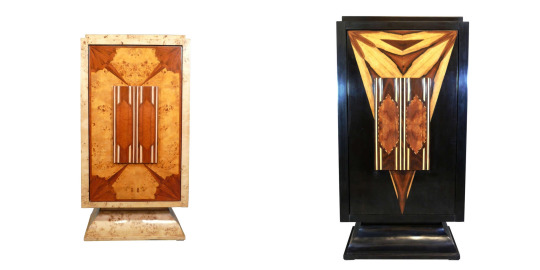
El escritorio: Se distinguen principalmente por su diseño geométrico y acabado refinado. El barniz se aplica a todo el marco y al almacenamiento de una manera tradicional para conservar las características y la originalidad de los muebles de los años 30.

Aparador: Es un mueble utilizado como almacén para platos, mantelerías y provisiones. Por lo general, se coloca en el comedor.
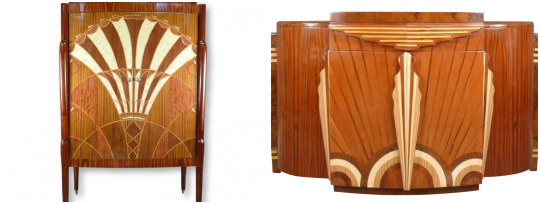
Los sofás: Están montados en un marco de madera maciza y con incrustaciones de especies de maderas preciosas, este mobiliario de sala de estar se cubre con telas de alta calidad, cuero genuino o imitación de cuero para crear una decoración interior de la época de los años veinte.

La silla: Se distingue por su estilo limpio, su color a menudo oscuro, pero especialmente sus materiales nobles, resistentes y fáciles de mantener.

Arquitectura Art Deco
youtube
youtube
Art Deco en las pantallas del cine y la música
youtube
Ilustración

3 notes
·
View notes
Link
A black and white portrait of Che Guevara casts a watchful eye over a room adorned with socialist memorabilia from all over the world. A sculpture of two giant marble fists bound by a broken metal chain inscribed with the name “Marinaleda” has pride of place on a grand wooden desk. Behind it sits a small, bearded man wearing a Palestinian keffiyeh scarf and a multicoloured shirt. His name is Juan Manuel Sánchez Gordillo, mayor of the last communist town in Spain.
“Capitalism is like King Midas,” he tells me, “everything it touches turns to gold, commodity, trade and death. I think the capitalist system is necrophilous.”
The 70-year-old has run Marinaleda, near Seville, for almost 40 years, having spent decades fighting the system to create his “utopian” village. Many are starting to question whether this “paradise” will last much longer, after the Socialist PSOE failed to gain an absolute majority in Andalusia’s regional elections in December – for the first time in history. For four decades, Marinaleda has been granted free rein under the Socialists but that would not be guaranteed under a right-wing coalition, which could soon be formed between the Partido Popular, Ciudadanos and far-right party Vox.
Perhaps surprisingly, some 44 people in the town voted for the extreme right party, which won its first ever seats in parliament. But it will probably take more than Vox’s 12 seats to topple Europe’s last communist outpost, which has been a unique success story for decades.
As unemployment stands at 22.9 per cent in Andalusia, only 4 per cent of Marinaleda’s 3,000 citizens are out of work and that is mostly “their choice”. Every civilian is offered a job with the same salary and a house with a mortgage of just €15 (£13.50) a month, while the total cost is deducted if the occupant helps towards building and upkeep.
The town’s success lies in a cooperative where villagers work in the fields or factory to earn €47 for a six-and-a-half-hour working day, bringing in €1,200 a month. Even the unemployed receive €400 from Andalusia’s regional government each month. Although large companies and chains are not permitted, the mayor insists he does not stand in the way of small businesses.
As well as 352 hectares of olive groves, Marinaleda also cultivates broccoli, artichokes, broad beans and peppers, which are jarred at the factory and distributed across the country, creating a year-round harvest.
“The more vegetables we cultivate, the more work we create,” says Sánchez Gordillo. “The money from sales is reinvested into the town to improve the community. It is never for anyone’s personal profit. The land is for anyone who wants it.“
Marinaleda’s journey to utopia began after years of deep repression under General Franco’s harsh fascist regime, when Sánchez Gordillo saw “hunger reach the stomachs of many labourer families” with an unemployment rate of 80 per cent.
Four decades later, El Sindicato de Obreros del Campo (The Union of Farm Workers) was born, leading to the first democratic elections held in Spain – in 1979 – since the collapse of the Republican government. The workers’ collective CUT (Colectivo de Unidad de los Trabajadores) gained an absolute majority in Marinaleda and at the age of 30, Sánchez Gordillo was elected mayor – a position he has upheld ever since.
But “La Lucha” (the fight) would plague the town for another decade as the CUT attempted to take political control over Marinaleda, by staging a 700-strong “hunger strike against hunger”. For more than 90 days Marinaleda villagers occupied the Cortijo de los Humosos, a farmhouse owned by a wealthy duke who left its vast fields uncultivated while families starved. Daily, the Guardia Civil violently expelled them, and daily they returned.
Finally, seven years later, the Andalusian government granted them the land and Marinaleda has never looked back. Now the rustic farmhouse bears the proud words: “This land belongs to all the unemployed labourers of Marinaleda.”
“After all this, we know there is nothing you can’t achieve. Even your wildest dream can become a reality,” says Sánchez Gordillo as we gaze up at a decaying wall painting reading “Tierra Utopia”.
And it is not just local Andalusians who have looked for paradise in this small corner of Spain. Christopher Burke is one of the six British residents living in Marinaleda. The 70-year-old Liverpudlian moved to the town eight years ago with his wife after falling in love with the community spirit during a holiday.
“This place grabs your heart, people are so kind and it’s not about money here,” he says. “It’s great to be part of something that has a different outlook on society and see whether this system is actually achievable. I would say it definitely is.”
He smiles as he tells me how locals regularly pop over with freshly baked bread and recounts stories of the town’s festivals, where even the mayor waits on tables. If it were not for Brexit, Burke says he would never go back to the UK. “If we lose healthcare in Spain I’m absolutely done for because I have glaucoma. It’s a big problem,” he says.
And it seems the town’s folk are also content. As the sweltering sun beats down on us in the lush green fields, young farmer, Alba Martin tells me she has no plans to leave after experiencing life in the outside world.
“The work here is fairer than in other places in Spain,” says the 24-year-old Marinaleda native, speaking from bad experience in Mallorca where she was crippled by her €600-a-month income. “Life is relaxing here, you live well, you’re paid well and above all, things are cheap. The workers are really looked after here.”
Picking broad beans beside her is 42-year-old Antonio Casares, who returned to his native town six years ago after working in construction in Barcelona, Ibiza and others parts of Andalusia. He too worked for a “miserable” salary of €600.
“You can’t live on that,” says Casares, whose wife and teenage daughter work alongside him in the fields. “I had to come back at the beginning of the economic crisis when everything became so expensive. The working days are a lot shorter and life is better here, you feel protected.”
Casares believes in Marinaleda’s model as it has provided almost everyone with a job and he says it’s all thanks to the mayor, who is voted in with an overwhelming majority every year. “If it weren’t for him, we would not have this,” he says gesturing towards Sánchez Gordillo, who is quietly eating freshly picked beans across the field.
It is clear the town’s folk greatly respect the mayor, who was allegedly the subject of multiple assassination attempts by the Guardia Civil for his political protests. He makes time for everyone he bumps into on the street, as they gossip and ask for advice like a close friend. Time, it seems, is not an issue in Marinaleda.
A history teacher until four years ago, Sánchez Gordillo lives on a modest street of small terraced houses. It is well known he has never taken a mayor’s salary and earns the same as everyone else.
“I don’t think anyone is more important than others,” he tells me after asking to be called by his first name as he finds it more “comfortable”.
During the throws of the recession, the revolutionary made international headlines after leading his union to raid supermarkets to provide food for the hungry. Many called him a “Robin Hood”, others a robbing troublemaker.
“The true thief is capitalism,” he insists. “It is a thief of human rights. Europe is the biggest food importer in the world, yet it is throwing its farmers and labourers into bankruptcy.”
And what would he say to people who call him a rebel? “Well I am a rebel,” he responds with a mischievous smile. “Rules are made to be broken.”
Yet when rules are broken in police-free Marinaleda, civilians face nothing more than a stern word from the mayor. “We do not punish anyone. Education is better than repression,” he insists.
However, Burke is concerned some take advantage of the lenient laws of the village.
“Sometimes there’s too much licence for people to do whatever they please,” he says. “Because it has a reputation of having no police, it can attract people buying and selling drugs from other places – like a mini drug market.”
Although Marinaleda is dubbed communist, the mayor describes it as a melting pot of ideologies – socialism, communism and humanism. He draws inspiration from the likes of Gandhi, Lenin, Marx and, of course, Che Guevara. Unlike strict communist models, he believes this watered-down version can work anywhere in the modern world.
“The main objective should be to conserve public property, such as land, housing and energy,” he explains. “There needs to be a direct exchange between the producer and the consumer, with no private business in the middle. If we continue to be ruled by money and by the selfishness and criminality of the global market, we will be on our way to the Third World War.
“The global system right now is just a new type of fascism,” he adds, while admitting that his “utopian” model is difficult to achieve as many don’t like sharing their wealth or possessions.
As the threat of the right looms like a dark cloud over Marinaleda and with elderly Sánchez Gordillo facing recent severe health problems, there is one question many do not want to confront: what will happen when he is no longer there?
“It’s the $64,000 question,” says Burke. “People want it to carry on but he is the central pillar. There’s no obvious successor.”
And it is too early to know if the mayor’s only son, aged seven, will continue his legacy.
Only Sánchez Gordillo is not worried.
“This is a collective effort,” he says simply. “I’m not sure what will happen but I would like the project to be continued for a future of solidarity. And I have faith it will.”
13 notes
·
View notes
Photo

Inktober Day 5: Build(Construir) Material: Este pueblo obrero del norte de Europa ha sido subvencionado por una superpotencia para realizar la construción de un automata capaz de destruir cuidades con las manos El mas minimo descuido en su montaje y este gigante podria matarnos a todos🤖 🌸SakuraPigmaMicron 00.3/00.5/0.1 🌸BrushPenPentel ______________________________________________ #jackbattyart #draw #ink #pen #build #illustration #inktober2019 #horrorart #dibujo #myart #halloween #sakurapigmamicron #sketchbook #inkdoodle #inktoberday5 #drawing #sketch #darkart #ink #dailysketch #inktober #dailydrawing #pencil #tintubre #inktuber #spooky #traditionalart #inkpen #doodle #inktober2019day5 https://www.instagram.com/p/B3PQ1tRIpG_/?igshid=17m3f1m4mgoga
#jackbattyart#draw#ink#pen#build#illustration#inktober2019#horrorart#dibujo#myart#halloween#sakurapigmamicron#sketchbook#inkdoodle#inktoberday5#drawing#sketch#darkart#dailysketch#inktober#dailydrawing#pencil#tintubre#inktuber#spooky#traditionalart#inkpen#doodle#inktober2019day5
2 notes
·
View notes
Photo

[Building] Cristo Obrero church in Atlántida, Uruguay. Author engineer Eladio Dieste AKA Lord of the Bricks. More information in comments. via /r/architecture https://ift.tt/2OfxaZZ
40 notes
·
View notes
Text
The Unidad Obrera and Its Antecedents
The first meeting of the obrera union took place in Mexico City on January 8, 1936. Delegates and observers from different countries and organizations participated in the gathering. The First Conferencia Americana of Labor, or the obrera Congress, was held on 8 September 1938. Vicente Lombardo Toledano, the leader of the obreros, was elected as president of the confederation.
Although the obrera union was a spontaneous occurrence, the pact for obrera has continental and international antecedents. It has occurred during a period of crisis and liberal questioning in the region. It is a latinoamerican movement that is characterized by the ascent of totalitarians. However, its antecedents are much more complicated than that.
The obrera movement in Mexico was first organized in Uruguay. It soon reached Chile, Cuba, and Ecuador. Later, it was organized in Uruguay. The CSLA ratified the pact, and it was endorsed by all the countries of the region. It was a significant moment in the history of obrera politics in Latin America. It marked the beginning of the rise of totalitarian movements.
The obrera movement in Mexico was founded in 1936. It sprang from the struggles of the obreros in various countries. The group was able to hold two meetings in Santiago, Chile, but the lack of a central union made negotiations with employers difficult. It was not until the late 1930s that the obreras were able to organize themselves and form a united front.
The obrera union in Mexico was based on a consensus on the issues and concerns of the working class. The party was founded on the principle of unity and solidarity, and the workers' vanguard acted as a common voice. It was established to oppose imperialism and establish a new socialist society in the country. Its formation was made possible only after the CSLA ratified the pact.
As the obreras came to power in the mid-1930s, they began organizing and forming a union. In the meantime, the movement also took root in Chile. As a result, the obreras' unity and the pact have remained in the world today. This pact was signed in October 1936 and ratified in 1970. In the 1980s, the obreras in Mexico were able to achieve the aims.
The pact for obrera's emergence came from a meeting of the obreros in Chile in 1936. The obreras' representatives discussed the problems facing the obrera class in America and signed an unknown pact. In the early obrera union, this pact has led to the formation of the Congreso Obrero Latinoamericano, or the Latin-American Congress.
The pact for the obrera union has continental and international antecedents. The pact for obreras in the United States and Canada, for example, signed a similar pact in the 1950s. Both groups signed the pact in order to achieve the goal of obrera unity. These conventions are a definite step forward and an important step towards building a better world for all people.
The pact for obrera union was a landmark event for the obreras. It was the first major pact for the obreras in the world, and it was a step in achieving freedom for all people. Despite the pact for obrera, it is still an important milestone for the obreras. The pact is a vital step in achieving independence for the obreras.
In 1936, the pacto of unity was signed between the obreras of the United States. The pact is an international treaty between the obreras and their allies. The pact was a major milestone in the struggle for independence for the obreras of Chile and Mexico. The obreras' pacts were also a catalyst for establishing unification across the rest of the world.
A pact for unification in Latin America was a landmark event for obreros. It paved the way for a new political system and the possibility of a freer future for the obreros. With the pact, obreros could finally achieve their goal of a more just society for all people. This agreement was a landmark in the struggle for liberation in Chile and Latin America.
0 notes